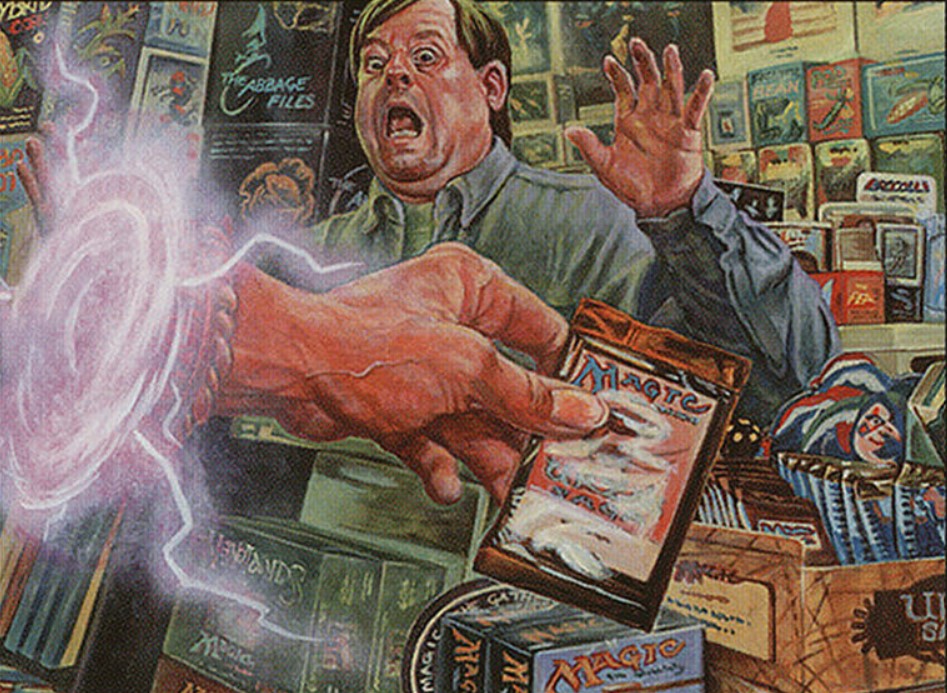Are you a Quiet Speculation member?
If not, now is a perfect time to join up! Our powerful tools, breaking-news analysis, and exclusive Discord channel will make sure you stay up to date and ahead of the curve.
It’s time for a pop quiz! Have a look at the screenshot taken below from Card Kingdom’s site:
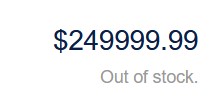
What product do you think this is from? What could Card Kingdom possibly charge $250,000 for, yet still remain sold out? It’s not Alpha Black Lotus—those are sold out too, but with a $149,999.99 price tag, a full $100k less than this other listing! In fact, you can’t even get a Black Lotus (or any piece of Power for that matter) from one of the answers.
Give up? The answer is twofold, actually, because there are two Magic products sold out at Card Kingdom’s site with the $250k price tag:
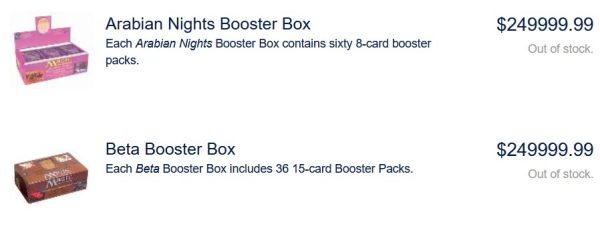
In all fairness, I doubt $250k is the “market price” for these products. In reality, supply is so low that Card Kingdom can put whatever number they want here… it’s unlikely they’ll be restocking these anytime soon. The most valuable booster box they do have in stock, by the way, is Legends, with a $50,000 price tag.
This week I’m going to do a deeper dive into these holy grails of Magic collecting and attempt to explain at least some reasons why these prices have gone through the roof, beyond simply their age.
Box EV Disconnect
When I saw the $50,000 price tag for a booster box from Legends, I must admit I was initially quite baffled. Flabbergasted, even. The most valuable card from the set is The Tabernacle at Pendrell Vale, which is worth around $5,000 in near mint condition. Let’s face it: in a booster box with 36 packs, you’re not going to open more than one or two of these. The same can be said for the next most valuable cards, Chains of Mephistopheles ($1600), Moat ($1500), and The Abyss ($1300).
In determining the box’s EV, we also need to consider that you are just as likely to pull a $10 Kei Takahashi or $12 Teleport as your rares from various booster packs. There are probably fifteen to twenty rares that are worth around $20 or less. If you’re paying $50,000 for 36 booster packs, that’s nearly $1400 per pack—opening one of these $20 rares would be a tremendous feel-bad, but it’s virtually guaranteed to happen in some of the packs out of a box.
In fact, Dawnglare has the set EV for Legends estimated at $9,326.71 for a booster box as of this article’s writing, about one-fifth the price of the booster box Card Kingdom has in stock. Arabian Nights’ set EV for a booster box, by the way, is just over $80,000.
Why is there a huge disconnect between set EV (the estimated value of cards you’d open from a booster box) and the actual booster box price? Well, I’m sure collectability and age has something to do with it. If I peel back the onion, however, I can find a couple more reasons.
Seeking Out Those High Grades
When someone cracks open a booster pack of Legends or Arabian Nights, they don’t just open a Moat or Shahrazad, or any array of cards from these classic sets. They open near mint copies of these cards. If they’re lucky, they may even open grade-worthy copies of these cards. That is a whole new ballgame.
Consider this: I’ve been in the market for a nicely graded Shahrazad for a while now. I think it would be neat to have the card in a BGS case on display on my shelf at home. I figure if a near mint copy is worth around $600, maybe a graded 9.0 copy would be slightly more.
No such luck. In fact, BGS 9 copies have sold for over $1000 recently on eBay. That begs the question: what would a BGS 9.5 copy sell for? It just so happens that two BGS 9.5 copies sold on eBay at auction this month, and both ended north of $2000! I won’t get into the science of subgrades this week (that could be a subject for an entire article), but these two copies were “basic” 9.5’s because they had one subgrade of just 9.0. Had these been all 9.5’s or higher, these copies would have sold for significantly more.
It turns out, highly graded copies of cards from Legends, Arabian Nights, etc. are quite collectible and valuable. When you’re talking about BGS 9.5, even the commons and uncommons can carry significant value. For example, Segovian Leviathan is a $3 uncommon from Legends, but this BGS 9.5 copy sold on eBay for $219.99! That’s a 73x multiplier!

Now all of a sudden, instead of pulling $5 uncommons and $25 rares, you’re pulling gradable cards worth $100’s each. I suspect even BGS 9.5 commons are still worth submitting for grading if they are nice enough to merit a 9.5. This would definitely bring up a box EV’s significantly, and it’s another reason these old boxes sell for so much.
Box Breaks
What is a box break, exactly? This is a trend that started in the sports card world, but has carried over to other collectible card markets such as Magic and Pokemon in recent years. The premise is simple enough. A box break is a live online event where buyers purchase “spots” from the breaker (the seller) to obtain high-value cards. The breaker opens the box and ships cards to the buyers of the spots.
There are two really attractive facets to box breaks. First, these events are done live in real time, meaning multiple people can experience the thrill of opening the booster box simultaneously. Even though you don’t have the booster box in your possession, you can still observe exactly what you are effectively opening at the same time as everyone else. There is a kind of thrill to this experience.
Especially when you take the second facet into consideration—the fact that you can afford to participate in opening a booster box that you otherwise would not have had the funds to do.
For example, a Revised booster box retails for around $14,000. That’s a tough pill to swallow. Personally, I’d rather have a heavily played Unlimited Black Lotus than spend $14,000 on a booster box. Instead of attempting to save up funds to make such a purchase, I could instead participate in a Revised booster box break. A Revised spot may only cost $420 for a pack, for example. Now I can effectively open an unsearched Revised booster (since sealed booster boxes obviously can’t be searched) at a more affordable price point.
Here's an example of a Revised box break done last year.
Meanwhile, instead of trying to find a buyer in the market for a $14,000 Revised booster box, the breaker instead pieces out the box in small, more affordable chunks, and may even make more money in the process.
The thing is, there are very limited quantities of these old booster boxes still in existence. If box breaks are catching on, then more sealed product could be opened, leading to a reduction in supply (in tandem with the increased demand due to the popularity of box breaks).
The result: rising prices. Box breaks don’t have to involve Magic’s oldest sets, either. Any booster box from Magic’s 29 year history could be exciting to open via a box break. This could lift prices of any booster boxes with relatively limited supply. Here are a couple other examples of older booster box price points:
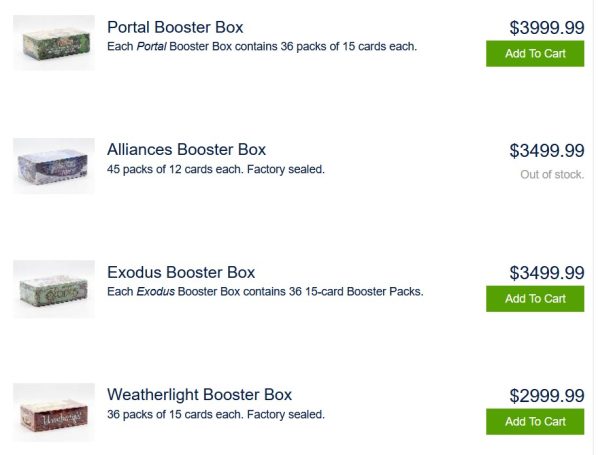
Each of these could be attractive candidates for a box break. While there are a smattering of valuable Reserved List cards in each of the above sets (sans Portal), box EV alone can't be driving up these prices. There must be other forces at play.
Wrapping It Up
The more I study older sealed product, the more complex I believe the market is. When you get to the extremely rare product—particularly sealed Alpha, Beta, and Arabian Nights—you almost have to work with some intermediary to obtain the item. You can’t simply navigate to a TCGplayer, eBay, or Card Kingdom to make the purchase. This is more akin to the high end art market, where a given item may only be available for sale through connections, or on rare occasions.
As a result, my work investigating these collectibles is far from over. Consider this the first chapter of a dedicated series on the subject. As I garner sufficient information, I’ll write up another article to highlight these insights. It could take months to do the topic justice.
By the way, I wrote about investing in MTG booster boxes back in 2012. Below were prices per box from Star City Games’ site at that time:
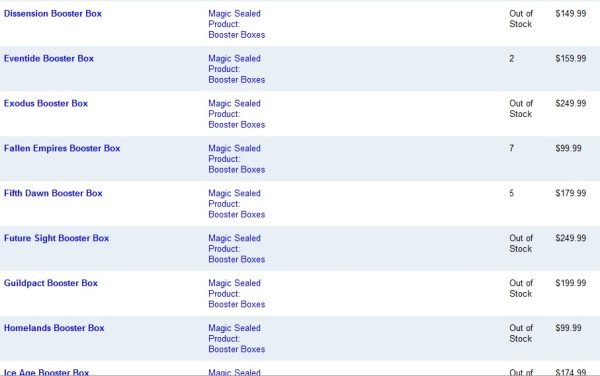
How do those prices compare vs. today?
Set – Price in 2012 (SCG) – Price in 2022 (CK)
Dissension - $149.99 - $999.99
Eventide - $159.99 - $799.99
Exodus - $249.99 - $3499.99
Fallen Empires - $99.99 - $799.99
Fifth Dawn - $179.99 - $1199.99
Future Sight - $249.99 - $2499.99
Guildpact - $199.99 - $849.99
Homelands - $99.99 - $849.99
Ice Age- $174.99 - $1399.99
Yup. I’d say I’m definitely onto something here.
Disclaimer: some members of QS staff own and collect old sealed product.


